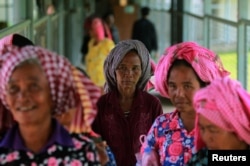More than 40 million people were trapped as slaves last year in forced labor and forced marriages, most of them women and girls, according to the first joint effort by key anti-slavery groups to count the victims of the often hidden crime worldwide.
The International Labor Organization (ILO), the human rights group Walk Free Foundation and the International Organization for Migration (IOM) said 40.3 million people were victims of modern slavery in 2016 — but added that this was a conservative estimate.
They estimated 24.9 million people were trapped working in factories, on construction sites, farms and fishing boats, and as domestic or sex workers, while 15.4 million people were in marriages to which they had not consented.
Almost three out of every four slaves were women and girls and one in four was a child, with modern slavery most prevalent in Africa followed by Asia and the Pacific region, said the report released Tuesday.
"It's a conservative number," Andrew Forrest, founder of Walk Free, told the Thomson Reuters Foundation. "It cannot capture the full extent of the horror of modern slavery."
No region exempt
In the past five years, 89 million people suffered in some form of modern slavery, lasting from days to years, the report estimated.
"Forced laborers produced some of the food we eat and the clothes we wear, and they have cleaned the buildings in which many of us live or work," the groups said in the report, stressing the crime was prevalent in all nations.
The findings mark the first time the groups collaborated on an international estimate and prompted calls for stronger labor rights, improved governance of migrants, action to address root causes of debt bondage, and better victim identification.
"Having a global number shows the prevalence of the issue of modern slavery. It shows there is impunity around the world where people are being traded by organized criminals" and "being let down by systems," said Kevin Hyland, Britain's independent anti-slavery commissioner. "We need to see this translated into action that develops a response about how we safeguard people."
Previously the anti-slavery groups had used different data, definitions and methodologies to reach separate global estimates, said Kevin Bales, professor of contemporary slavery at Britain's University of Nottingham and a member of Walk Free's statistical team.
The latest estimate "is more accurate than any number that we've had previously," he said. "We just have better data and better methods than we've ever had before.
"It's a hidden crime," he added. "It's tricky to get at."
Child, sexual exploitation
The estimate compared with a 2016 Walk Free finding that 45.8 million people were slaves and an ILO figure of 21 million in forced labor, but both the ILO and Walk Free cautioned the latest number cannot be compared with earlier figures to show progress or failure in anti-slavery efforts.
But having an agreed-upon estimate can help galvanize anti-slavery efforts, said Jean Baderschneider, head of the U.S.-based Global Fund to End Modern Slavery.
"I'm so thrilled that they got this together. It's a big deal for the field today," she said.
Fiona David, executive director of global research at Australia-based Walk Free, said unlike previous estimates, the findings explicitly included people forced into marriages.
Many are women taken from their homes, raped and treated like property that could sometimes be bought, sold or passed on as inheritance, she said.
More than a third of the 15 million victims of forced marriage were under 18 when wed, and nearly half of those were younger than 15. Nearly all were female.
"Really the label marriage is actually a little bit misleading. When you look at what's behind it, it could also be called sexual slavery," she said.
Including forced marriage is a breakthrough that helps draw needed attention to the issue, Bales said.
"In a lot of countries around the world, they don't even want to discuss the idea of marriage ... in the same room as the idea of slavery," he said.
Child labor
The ILO also released a separate report showing 152 million children were victims of child labor, which amounted to nearly one in every 10 children worldwide, with almost half of those engaged in hazardous work.
More than two-thirds of these children were working on a family farm or in a family business, with 71 percent overall working in agriculture.
The calculation of forced labor included the private economy, forced sexual exploitation and state-imposed labor.
Half of forced laborers were victims of debt bondage, who were made to work to repay a debt or other obligation, and nearly 4 million adults and 1 million children were victims of forced sexual exploitation.
"The vast majority of forced labor today exists in the private economy. This underscores the importance of partnering with the business community ... to eradicate forced labor in supply chains," the report said.
The ILO and Walk Free conducted surveys in 48 countries and interviewed more than 71,000 people, with findings supplemented by data from the IOM.













